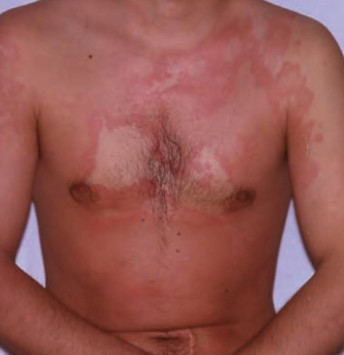What is serum sickness?
Serum sickness is an immune mediated type 3 hypersensitivity reaction, it happens due to large immune complexes deposition in small blood vessels of various organs such as the skin, joints and other systems different tissues.
What is the presentation of serum sickness?
Serum sickness patient usually presents with
- Fever
- Polyarthralgia/polyarthritis
- Arthralgias are more common than frank arthritis, but either may occur.
- The hands, feet, ankles, knees, and shoulders are most commonly affected.
- Rash.
- Others
- Nausea, vomiting, occult blood in the stool, and lymphadenopathy.
- Splenomegaly, anterior uveitis, peripheral neuropathy, nephropathy, and vasculitis.
What does the rash of serum sickness look like?
- The rash, which mostly is pruritic, may be:
- Urticarial : it lasts more than ordinary urticarial lesions.
- Maculopapular.
- Vasculitic (purpuric) eruption.
- The mucous membranes are not affected.
- If the causative drug has been injected, the rash may start at or near to the site of the injection.
- The rash resolves within days to weeks once the offending drug is stopped.
What are the possible causes of serum sickness?
As a result of interaction between non human and human proteins, immune complexes forms causing serum sickness. Examples for non human proteins may include :
- Drugs : Aspirin, Penicillin, Streptomycin, Sulfonamides, Thiouracils.
- Anti-venoms.
- Rituximab, infliximab, omalizumab, alemtuzumab, natalizumab, adalimumab, and obinutuzumab.
- Vaccinations : Rabies.
How long is the interval between the causative agent administration and the presentation?
- The presentation typically occurs one to two weeks after exposure to an offending agent and resolve within several weeks of discontinuation.
What about the prognosis of serum sickness?
- It is a self-limited benign disease process with an excellent prognosis.
- Educate your patient that re-exposure to the same triggering agent may induce more severe episode of the disease.
How you can distinguish between serum sickness and serum sickness like reaction (SSLR)?
- The presentation of both serum sickness and serum sickness like reaction is similar, but pathologically, no immune complexes are formed. The exact pathogenesis of SSLR is not elucidated.
- Serum sickness is more common in adults than in children, but serum sickness like reaction is more common in children.
- In case of serum sickness and because of the activation of complement system, circulating C3 and C4 will be low in contrast to SSLR, in which C3 and C4 levels are normal.
- Systemic involvement of the kidneys and liver is rare, in contrast to true serum sickness.
- Circulating immune complexes, vasculitis, and renal disease are absent in SSLR.
- Serum sickness patients develop fever >38.5. on the other hand, it may not develop in SSLR or tends to be low grade fever.

What are the causative agents of serum sickness like reaction?
- Antibiotics are the main causes of SSLR
- Penicillins, cephalosporins (most commonly cefaclor), and trimethoprim-sulfamethoxazole, bupropion, fluoxetine, phenytoin, sulfonamides, minocycline, propranolol and thiouracil.
- Infections: streptococcus and hepatitis B.
- Skin disease at the time of acute HBV infection most commonly manifests as serum sickness‐like reaction.
- Vaccines : Rabies, influenza, tetanus, and pneumococcal vaccines.
- Mosquito bites
What is the presentation of serum sickness like reaction?
- Patient usually presents with
- Arthralgia.
- Urticarial rash : Annular and polycyclic Urticarial rash of SSLR persists for more than 24 hours and may resolve leaving purpura. The lesions expand gradually leaving central clreaing.
- Lypmhadnopathy.
- Fever may be or not present.
- Acral edema (hands and feet), facial and periorbital edema may be present.
- The manifestations are less severe than serum sickness.
- No mucous membranes affection.
Which investigations that may be required for serum sickness patient?
If the patient is looking ill, you should consider the following investigations to exclude systemic affection and other possible causes
- CBC may show leukopenia or mild leukocytosis.,thrombocytopenia and easinophilia.
- CRP and ESR : raised in active disease.
- Urine analysis to exclude renal involvement, mild proteinuria and mild hematuria.
- Serum creatinine : may be increased and returns back to normal within few days after removal of culprit agent.
- Liver function tests.
- Exclude infection if clinically suspected: hepatitis B, EBV.
- Complement levels : otal hemolytic complement (CH50), C3, C4 will be low in serum sickness but not in SSLR.
References
Bolognia, J., Jorizzo, J. L., & Schaffer, J. V. (2012). Dermatology. Philadelphia: Elsevier Saunders.
#Serum sickness and serum sickness like reaction #serum sickness like reaction #serum sickness rash